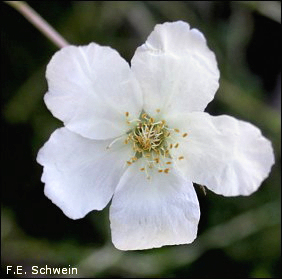
Apache Plume is a familiar shrub through most of the Chihuahuan Desert, especially along canyon and arroyo edges. It receives its name from the delicate, pinkish plumes attached to its seeds, being likened to the feather plumes attached to Apache gear. A member of the rose family, its white flower resembles that of the simpler wild roses. Flowers often are an inch or more in diameter and are plentiful in good years. The small dark-green leaves, white flowers, and pinkish plumes contrast to make this a beauty to enjoy.
Various animals, such as deer and Pronghorn, browse on its foliage,
especially when other foods are scanty. Southwestern Native Americans used a decoction
of leaves as a hair wash to promote good growth, bundles of twigs to form brooms, and
the older wood for arrows. A mixture of ingredients that included the plumes was used
by some Spanish New Mexicans to counter bewitchment. Today, the shrub is widely used in
the Southwest and elsewhere as a drought-resistant ornamental. Not bad for a poor
relative of the rose.
![]()
Contributor: Arthur H. Harris, Laboratory for Environmental Biology, Centennial Museum, University of Texas at El Paso.
Desert Diary is a joint production of the Centennial Museum and KTEP National Public Radio at the University of Texas at El Paso.
  :
 : 
Flower and fruit of Apache Plume (Fallugia paradoxic). Photographs by Florence E. Schwein.
Powell, A. M. 1998. Trees and shrubs of the Trans-Pecos and adjacent areas. University of Texas Press, Austin. 498 pp.
Vines, R. A. 1960. Trees, shrubs, and wood vines of the Southwest. University of Texas Press, Austin. 1104 pp.